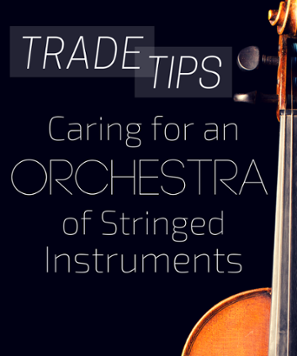
Caring for one instrument is not the same thing as caring for an orchestra's worth of instruments... or is it?
Whether you're responsible for maintaining a single instrument or fifty, there are certain tips and best practices that always hold true. That's why we've compiled a list of six trade tips that can help players, teachers, and other instrument-caretakers keep their instruments sounding great.
5 Tips That Will Keep Even an Orchestra's Worth of Instruments Sounding Great
1. Maintain a constant climate.
While this tip often finds itself tossed into the "common knowledge" category, it is always worth mentioning the fact that violins, violas, cellos, and basses suffer from goldilocks syndrome – too hot or too cold, too wet or too dry, simply will not do. They need things to be just right.
Ensuring that the rooms where the instruments are played (and the rooms where they're stored) are kept at a constant, instrument-friendly temperature and humidity goes a long way in maintaining quality and extending the life of a set of instruments.
2. When they aren't being played, instruments and bows belong in their cases.
This tip is doubly true for instruments that belong to primary or secondary school orchestras. The safest place for an instrument to be when it's not being played is in its case. This tip can go even further if young students are encouraged to take it to heart. There are few things more heartbreaking than a school instrument that's been sat on.
3. Cleanliness is a virtue.
Not to mention next to godliness. Taking a few minutes after each playing session to thoroughly clean an instrument (making sure to wipe down the fingerboard, top plate, bridge, and the stick of the bow) is a simple measure that will help keep any instrument sounding, and looking great. If left to build up over time, rosin residue can become difficult to remove, and while there are commercial cleaners and kits available, even of the best of them have the potential to damage the instrument. A simple micro-fiber cloth and a light touch are all you need if instruments and bows are wiped down frequently, and not allowed to gather dirt and grime.
4. Don't horse around with bows or bow hair.
Our poor attempt at horse humor aside, it's true. Remembering the little things (like avoiding over tightening, loosen before putting it in a case, and that the natural oils in our hands and fingers can easily damage bow hair) is a simple way to help a bow last and make sure that it can perform its best. We've also seen our share of young students engaging in imaginative swordplay behind the teacher's back. Students should be taught to respect the bow and understand that waiving it around haphazardly will lead to irrevocable damage.
5. Leave the repair work to the professionals.
It's been said that there are two types of people who open the back of a watch: a fool and a watchmaker. The same principle applies to string instruments and string instrument repair. While an amateur repairman might be armed with good woodworking skills and the best intentions, it doesn't take much to do more harm than good. Even for tiny repairs, it's always best to take instruments to a shop and put it in the hands of a professional luthier. It's easier, and less costly, for a luthier to fix a problem the first time, than trying to undo the damage that an untrained hand can reap on the instrument.




Leave a comment